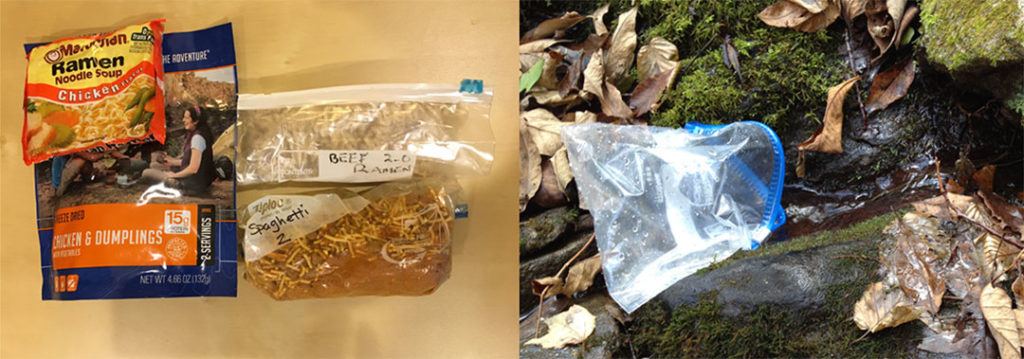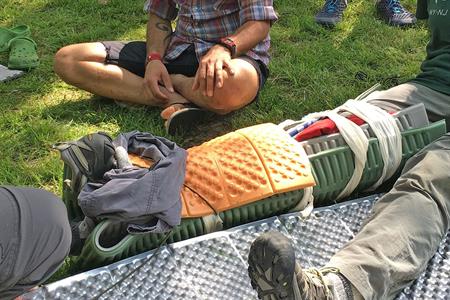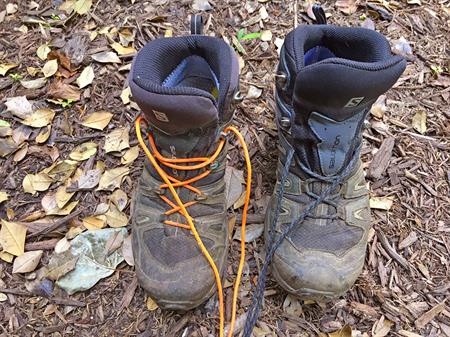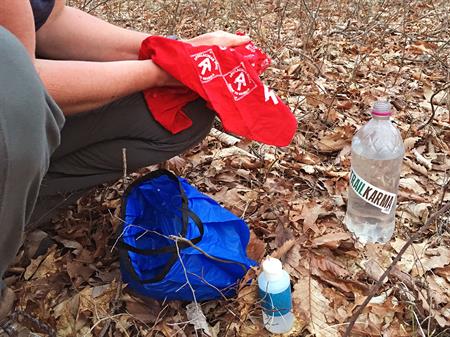by Jim Fetig, Potomac Appalachian Trail Club
A.T. Hiker Hacks: Simple & Cheap Ways to Enhance Your Next Backcountry Adventure
July 20, 2018
“Are you out there to camp or to hike?”
This was the most important question anyone asked me while I was preparing to thru-hike the Appalachian Trail (A.T.). The theory of the question is that hikers carry only what they absolutely need. Campers, on the other hand, may consider comfort and convenience more important, and therefore choose to carry more (and heavier) stuff.
As summer backpacking and section hiking seasons hit full swing, that pivotal question is worth asking again.
Fortunately, there are many common hacks worth knowing that can make life on the trail lighter, easier, safer and less costly no matter when you choose to go.
A few rules of thumb are worth pondering. For example, pack weight can be reduced if certain items can serve multiple uses, or if common items can be substituted for heavier and more expensive specialized gear.
Here are a few common helpful hacks
 Plastic peanut butter jars and soda/water bottles substitute well for heavier and far more expensive water bottle models such as Nalgene. They are much lighter in weight, easily replaceable and plenty strong. Sawyer and other similar filters fit on soda/water bottles as an added advantage on hot summer days: you can drink right away when it’s hard to stay hydrated rather than wait for chemical treatments to work.
Plastic peanut butter jars and soda/water bottles substitute well for heavier and far more expensive water bottle models such as Nalgene. They are much lighter in weight, easily replaceable and plenty strong. Sawyer and other similar filters fit on soda/water bottles as an added advantage on hot summer days: you can drink right away when it’s hard to stay hydrated rather than wait for chemical treatments to work.
The lowly ziplock bag has to be the Swiss Army knife of outdoor equipment — aside from an actual Swiss Army knife, of course. Depending on size, they can collect water from impossible places, be your wallet, keep anything dry — clothes, camera, phone — store your trash, carry snacks and help you stay organized in general. Many hikers, maintainers and ridgerunners always carry a quart ziplock in their pocket to collect small pieces of trash found littering the trail.

In addition to all of this, you can pack or repack freeze-dried or dehydrated foods in ziplock freezer bags to reduce weight and trash volume, and then rehydrate your meal right in the bag. Post-meal clean-up is as simple as rolling up the used bag, zipping it closed and dropping in your trash bag. Bonus: no dirty pot to clean.
 Smaller knives weigh less and can do the work of larger, heavier ones. The tiny executive model Swiss Army knife has scissors, tick-removal tweezers, a flat-tip screw driver and nail file in addition to a razor sharp blade. Unless you’re planning to skin and dress game animals larger than squirrels, one of these tiny tools ought to do the job.
Smaller knives weigh less and can do the work of larger, heavier ones. The tiny executive model Swiss Army knife has scissors, tick-removal tweezers, a flat-tip screw driver and nail file in addition to a razor sharp blade. Unless you’re planning to skin and dress game animals larger than squirrels, one of these tiny tools ought to do the job.
Dental floss serves as strong repair thread for rips and holes in clothing and other gear, and zip ties can repair broken buckles, zipper pulls or pack loops. Making long zipper pulls with zip ties also makes them easier to operate when wearing gloves.
A $15 dollar hardware store headlamp works fine for most people — you’ll be able to see just as well with one of these when compared to one of the $80 “pro-hiker” models.
Anytime an item in your pack can serve double-duty is an extra. A good example is wearing your puffy jacket — regularly needed for the morning and evening chill — in your sleeping bag to increase its temperature range. This allows you to carry a lighter bag or quilt while still staying toasty at night.

In the event of an emergency, clean clothing can substitute for a compress bandage in circumstances of heavy bleeding. Sleeping pads make excellent splints, as do hiking poles.
Hand sanitizer can be effective deodorant (though remember: everyone else probably stinks as much as you do). It’s really gelled alcohol, which also makes excellent fire starter.
 A chunk of the paracord line you use to hang food can replace worn out shoelaces.
A chunk of the paracord line you use to hang food can replace worn out shoelaces.
Loosening up comfortable trail runners eliminates the need for camp shoes.
1 oz. snow stakes cost less than $3 dollars and are as effective as the larger potty trowels and certainly far more effective at cat hole digging than boot heels or trekking poles.

Installing a Sawyer filter directly in-line with your water bladder eliminates the need for squeeze bags.
A common tea bag helps neutralize odors when packing out strong-smelling garbage and hygiene products.

A nylon dog bowl makes an excellent sink for washing up — remember that washing directly in a water source can introduce sunscreen, bug spray and large amounts of salt into a fragile ecosystem.
Other useful knowledge in common situations
If you are unwilling to carry a bear canister, learn the PCT method of hanging your food and practice it before you go. There are a number of “how to” videos on YouTube.
Stuck in icy spring, fall or winter rain? Put your fleece gloves in dish-washing gloves to keep your gloves dry and hands warm. You also can use first aid gloves in a pinch.
Speaking of staying warm, which often includes brisk New England summer mornings and evenings, buy clothing with extra-long sleeves that can be pulled over your hands and trekking poles.
If the temp threatens to fall below freezing, turn your water bottle upside down to avoid forming an ice plug or freezing the cap tightly shut.
Know how to pitch and strike your tent in the rain to minimize the amount of water that gets in the sleeping compartment. Hint: put up the poles and fly first.
There are a million things to learn and consider that aren’t hacks, but rather things that will both protect the Trail and help you better enjoy the natural world around you. For example, when choosing a campsite, pick a used site over creating a new one — this keeps the environmental impact of campsites from sprawling deeper into the woods. Study the ground for drainage (no one wants to wake up in a mud puddle after a late night rain shower) and poison ivy (do I need to explain that one?).
Look for “widow makers,” dead limbs overhead or trees that could crush your tent and — more importantly — you.
If there is no established fire ring, there is far less impact if you forego a fire altogether (and many sections along the A.T. don’t allow building fires outside of established rings, anyway). Building new rings and collecting firewood can leave long-lasting impacts on campsites and the surrounding environment, not to mention the backcountry experience so many seek on the A.T. And, of course, knowing the Leave No Trace principles should be required knowledge for anyone entering the woods.
Never forget that a little preparation goes a long way toward promoting success. There are excellent sources of knowledge starting with the Appalachian Trail Conservancy website, YouTube, blogs and journals, and many excellent books from hiking guides to adventure memoirs. “Know before you go” is a great motto: preparing properly can prevent unnecessary mistakes that can lead to discomfort or serious circumstances that risk prematurely ending a trip or becoming health and safety risks.
Mostly we learn by observing other experienced hikers and following their examples. Our fellow outdoor lovers can teach us a lot, including how to care for ourselves and the natural world around us as we explore the great outdoors.





